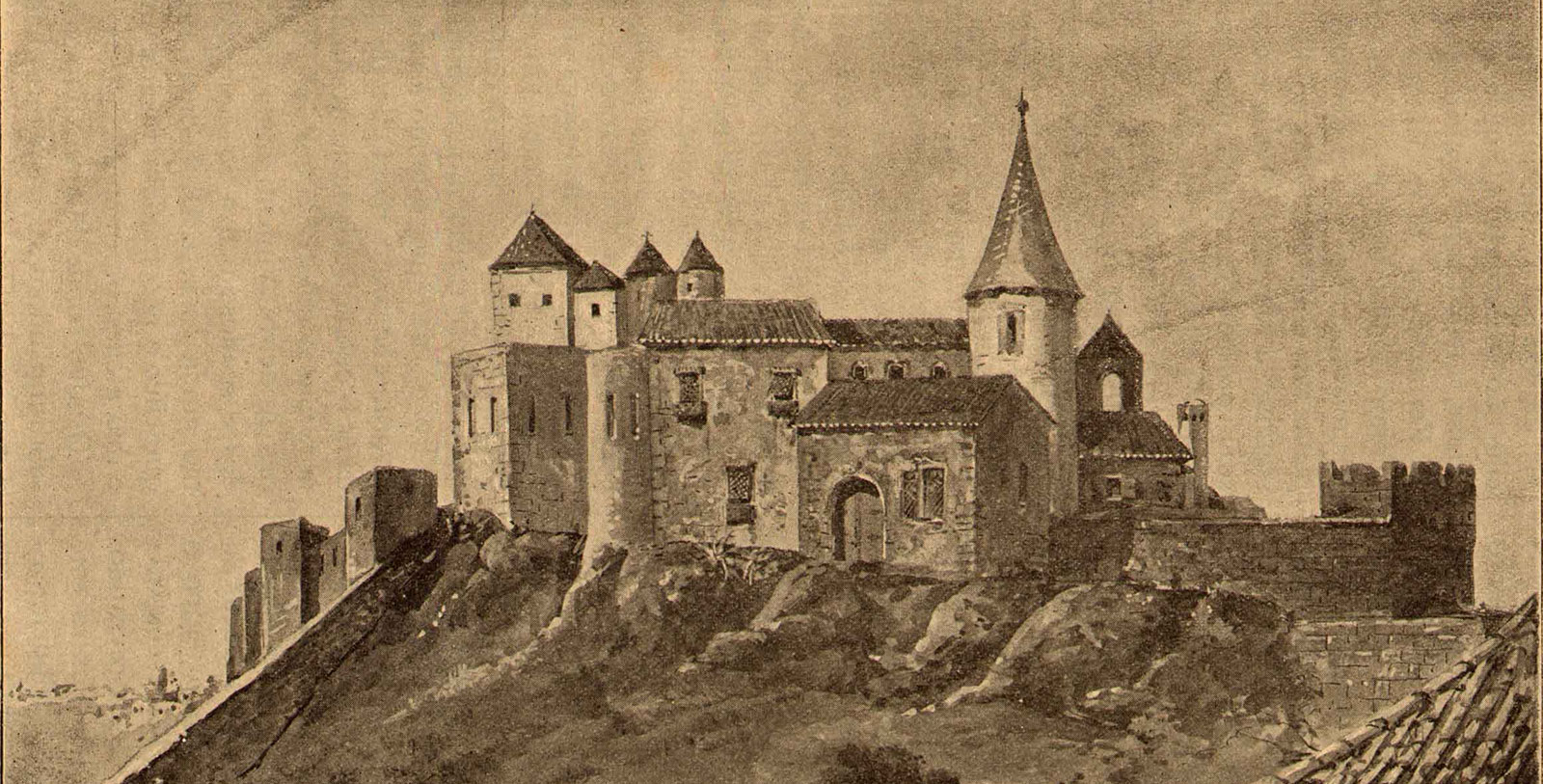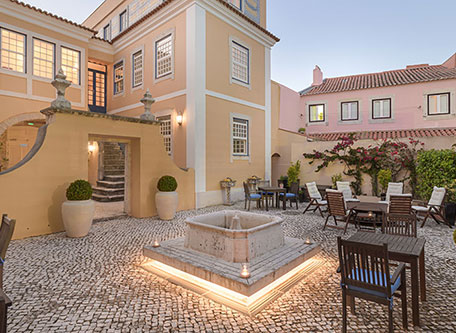Receive for Free - Discover & Explore eNewsletter monthly with advance notice of special offers, packages, and insider savings from 10% - 30% off Best Available Rates at selected hotels.
history
Discover the Solar do Castelo, which is part of a famous historic castle known as “Castelo de São Jorge.”
Solar do Castelo, a member of Historic Hotels Worldwide since 2022, dates back to the 18th century.
VIEW TIMELINERich in history, the Solar do Castelo is a fantastic destination located in the heart of Lisbon’s renowned UNESCO World Heritage Site. It is also set within the historic boundaries of Castelo de São Jorge (St. George’s Castle)—a famous historic castle that dates back hundreds of years. In fact, archeological evidence indicates that the citadel has stood for generations, with the earliest known battlements debuting in the 6th century A.D. Occupying an imposing spot atop a steep hill, the fort once guarded the roads that traversed the Targus in ancient Lisbon. (Other historical records have revealed that the crest was a strategically important site that many people—from the Romans to the Visigoths—tried to control in some capacity at one point or another.) But with the Umayyad conquest of the Iberian Peninsula, the castle became the main seat of power for the ruling Moors in the region. To solidify their hold over the area, they gradually redeveloped the castle to feature a series of interlocking walls and parapets. The revitalized defenses enabled the Moors to hold off numerous assaults from countless hostile forces until an army led by Afonso Henriques finally overwhelmed the garrison in 1147 during the Second Crusade. Henriques’ victory incorporated all of Lisbon into the newly formed Kingdom of Portugal, which he had helped forge a few years prior amid the Portuguese Reconquista.
The fortress itself continued to protect Lisbon from potential attack, defeating the neighboring Castilians several times throughout the latter half of the Middle Ages. At the climax of those conflicts, King João I decided to officially rename the fortress after Saint George—a legendary warrior that contemporary artists had typically depicted slaying a dragon. (The name was also chosen to pay tribute to the newly minted Anglo-Portuguese Alliance since Saint George was England’s patron saint.) Nevertheless, Castelo de São Jorge began to assume a secondary function as an official royal residence, with King Afonso III officially decreeing it his home in 1255. Successive monarchs instituted significant renovations to the castle that transformed the site into both a magnificent palace and an impenetrable bastion. For instance, King Dinis I ordered the creation of a series of regal apartments known as the “Real Alcáçova de São Jorge,” while King Fernando I commissioned the creation of the iconic walled compound that currently surrounds the castle today. The Portuguese Royal Family spared no expense in expanding the complex either, enlisting the expertise of such renowned architects like João Fernandes and Vasco Brás.
Following the relocation of the Portuguese royal court to the new Paço da Ribeira (Ribeira Palace) in 1502, the historic Castelo de São Jorge began to lose its cultural importance. The castle subsequently deteriorated over the next two centuries, culminating with its near destruction in the Great Lisbon Earthquake of 1755. Although most of the site remained dilapidated for decades thereafter, just enough of the grounds were renovated to maintain a military garrison. Additional construction projects coincided with the redevelopment efforts as well, including the creation of a brilliant mansion. The mansion itself debuted upon the location of the Real Alcáçova de São Jorge’s former kitchen complex a decade later and was henceforth called the “Palacete das Cozinhas,” or the "Mansion of the Kitchens." Thankfully, the entire location underwent a significant period of rehabilitation when the Portuguese government took a renewed interest in its future during the early 20th century. Declared a National Monument in 1910, the whole facility experienced a comprehensive renovation that saw much of its medieval fortifications fully restored. Now a celebrated historic landmark, Castelo de São Jorge is one of Lisbon’s most popular heritage sites. Many cultural heritage travelers have particularly enjoyed staying inside the neighboring 18th-century mansion during their visits, which made its debut as the “Solar do Castelo” in the 21st century.
-
About the Location +
While Lisbon today is among the most historic metropolises in Europe, its origins are a bit of a mystery. Historical evidence is scant regarding its founding, although recent archeological findings suggest the region was inhabited as far back as the Iron Age. Additional excavations in the heart of Lisbon have uncovered more artifacts that indicate a Phoenician presence dating back to the 12th century B.C. Those objects have enabled scholars to determine that Lisbon most likely formed as a Phoenician trading post that existed under the name “Olisipo.” Even though no record specifically cites the reasoning behind the title, some think that it was an homage to the legendary Greek hero Odysseus. Nevertheless, historians further believe that the village gradually grew into a massive city called “Felicitas Julia” following the Roman conquest of the Iberian Peninsula. The community served as the main bastion of power for the Roman Empire in the area, which developed imposing fortifications along the local waterway, the Tagus River. Those battlements specifically safeguarded the deep-water port at the river’s mouth, which had begun to flourish under Roman rule. But when the Roman Empire collapsed during the 5th century A.D., the settlement passed through various hands before finally getting captured by the Visigoths. They, in turn, lost control of the city to the Moors several centuries later. The Moors subsequently reinforced the city’s defenses, transforming the locale into an imposing bastion against European knights who wished to take it back. Their work reinforcing Lisbon was masterful, as the fortifications were able to blunt numerous attacks for decades.
In 1147, the Moorish defenses were put to the ultimate test when the Portuguese king Afonso I attempted to seize the city amid the Second Crusade (and the greater Portuguese Reconquista). At the head of a massive army, Afonso I managed to wrestle control from the Moors following a dramatic four-month-long siege. Now known as “Lisbon,” the city quickly emerged as an important commercial center in the nascent Kingdom of Portugal. Despite its rising economic status, the Portuguese Royal Family held its official court several hundred miles away in Coimbra. But King Afonso III decided to relocate the royal residence to Lisbon in the mid-13th century, thus making it the capital of the entire kingdom. Lisbon thrived due to its newfound political significance, with successive generations of Portuguese monarchs investing heavily into its continued development. Some of the most notable projects involved King Dinis I’s creation of the Studium Generale and the massive renovations that King Fernando I did to the ancient Castelo de São Jorge. Perhaps the greatest work to transpire occurred during the reign of King Manuel I, who oversaw the widespread urbanization of Lisbon. Among the best structures that he commissioned at the time included the Torre de Belém (Belém Tower) and the Paço da Ribeira (Ribeira Palace). Manuel had obtained much of the wealth to finance the construction via the great riches that had begun to flow into Lisbon’s harbor from Portugal’s newly created distant colonies. The amount of trade conducted became so great that Lisbon eventually established itself as one of Europe’s greatest cities by the end of the 16th century.
This renaissance came to an unfortunate end when a massive earthquake caused catastrophic damage throughout the city in 1755. Undeterred, the local residents banded together to rebuild most of Lisbon in a matter of years. Spearheading the revitalization efforts was Sebastião José de Carvalho, Portugal’s prime minister. He worked closely with a team of architects to redesign much of Lisbon’s historic districts, creating many new buildings in a simple, yet gorgeous style of Baroque architecture that became known as “Pombalino.” (The moniker was an homage to Carvalho, whose royal title was the Marques de Pombal.) Lisbon resumed its place as a prominent European community for many years, even as war, political instability, and economic depression periodically impacted Portugal in the 19th and 20th centuries. In fact, the city only continued to grow, as epitomized by the creation of a magnificent new thoroughfare that bisected the heart of Lisbon called the “Avenida de Liberdade” (avenue of liberty). The boulevard specifically debuted at the height of Europe’s Belle Epoque period in the 1890s. Following the country’s integration into the European Union at the start of the 21st century, Lisbon has solidified its standing as an elite, internationally renowned metropolis. Its rich character has inspired thousands of contemporary travelers to visit every year, placing it on par with other popular destinations throughout the Mediterranean Basin like Venice and Rome. Indeed, Lisbon’s many fascinating historic sites—including the Torre de Belém, the Paço da Ribeira, and the Castelo de São Jorge—have been essential for maintaining this incredible international interest. Most of those historic sites have also contributed to the creation of Lisbon’s spectacular UNESCO World Heritage Site, which encompasses large tracts of its downtown core.
-
About the Architecture +
Solar do Castelo displays some of the finest Classical Revival architecture in Lisbon, specifically a unique Portuguese subset known as “Pombaline.” Also known as “Neoclassical,” Classic Revival architecture itself is among the most common architectural forms seen throughout the world today. This wonderful architectural style first became popular in Paris, especially among French architectural students that studied in Rome in the 18th century. Upon their return, the architects began emulating aspects of earlier Baroque design aesthetics into their designs, before finally settling on Greco-Roman examples. Over time, the embrace of Greco-Roman themes spread across Europe, reaching destinations like Germany, Spain, and Great Britain. The specific “Pombaline” subset emerged in Portugal following the devastating Earthquake of 1755. The calamity had thoroughly destroyed much of downtown Lisbon, creating a residential housing crisis that affected much of the population. To find a solution, the Portuguese Prime Minister, Sebastião José de Carvalho e Melo, the first Marquês de Pombal, organized a government engineering team to reconstruct the heart of Lisbon. Manuel da Maia specifically oversaw all the work, redesigning the city’s irregular, medieval street grid for one favoring an orthogonal layout. Maia then coordinated with two other engineers— Eugénio dos Santos and Carlos Mardel—to craft the appearances of the new buildings slated to open along the rebuilt thoroughfares.
Unlike most other largescale European building projects, the construction undertaken by the Marquês de Pombal’s team created prefabricated, structurally sound edifices that were both durable and quick to produce. Indeed, most of the new buildings were originally constructed outside the city in individual parts and assembled on their respective lots. Due to a tight construction schedule and limited funds, the architects also used a more streamlined version of the popular Neoclassical aesthetic that was dominating the continent at the time. As such, most of the structures showcased similar designs featuring ground-level arcades and balconies on both ends of the structure. Every building also had a flexible wooden frame that could withstand external pressure and separate walls to prevent fire damage. At most, the new buildings also went as high as four stories to ensure a uniform appearance. While the architects allowed for some variance with exterior ornamentation, budgetary constraints meant that the buildings generally possessed comparable details. The architectural style thus relied upon restricted use of Neoclassical motifs like the symmetrical placement of doors and windows, as well as the use of a classical pediment. The new design gradually assumed its own identity, too, with local residents throughout Lisbon calling it “Pombaline.” Pombaline has since remained the most iconic form of Portuguese architecture in the city today. In fact, the architectural style played an instrumental role in getting the community’s historic core identified as a UNESCO World Heritage Site by the United Nations!


























